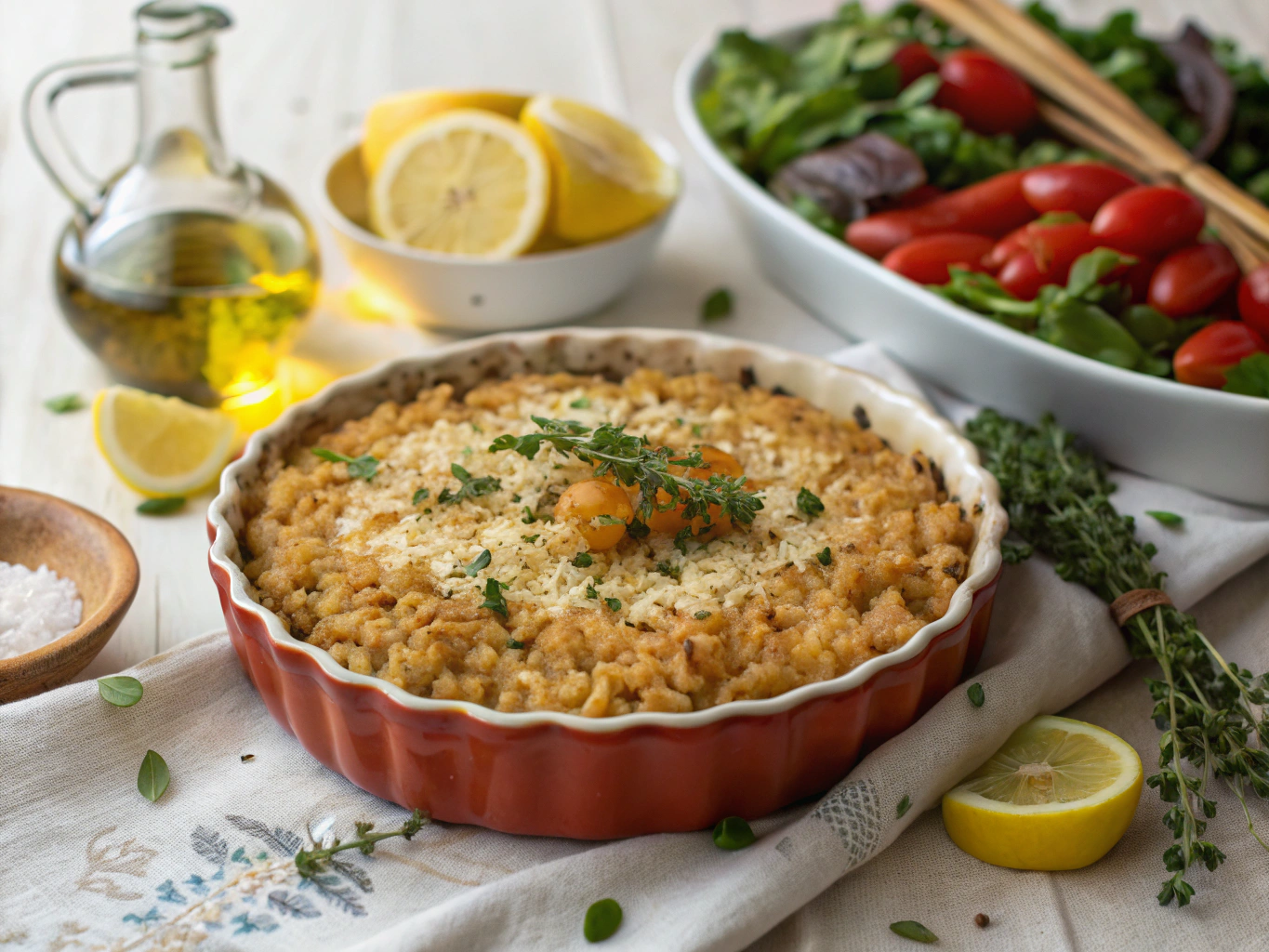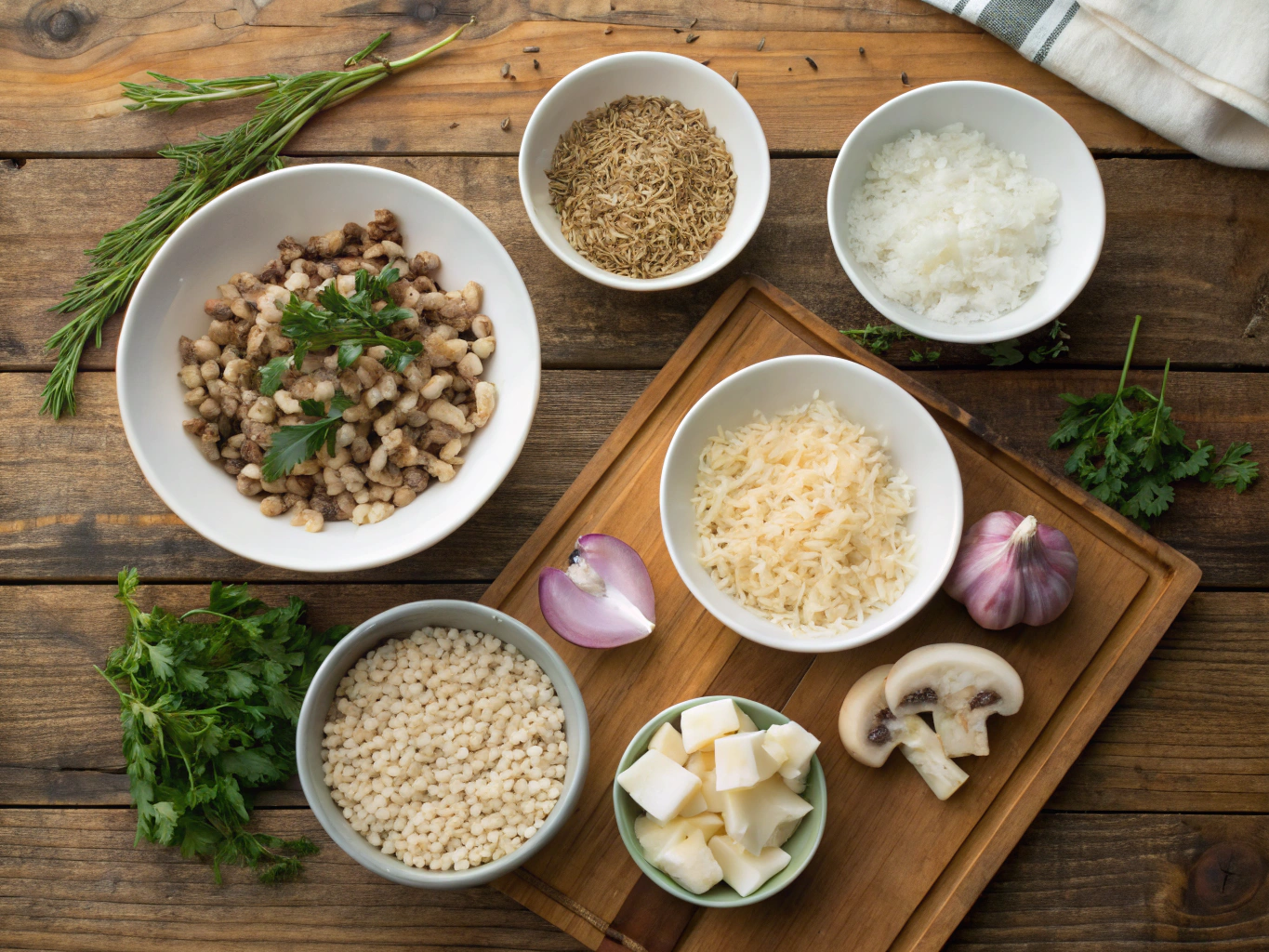
Table of Contents
If risotto feels like a luxury reserved for stovetop babysitting and constant stirring, let me share a little secret: baked farro risotto is not only hands-off, it’s also bursting with flavor, texture, and plant-powered magic. In this article, I’ll walk you through how to make this nourishing dish, infused with comforting herbs and creamy richness—without spending your evening ladling broth. We’ll cover the ingredients, techniques, and unexpected benefits that farro brings to your table. By the end, you’ll know exactly how to whip up this baked wonder with confidence.
My Journey into Baked Farro Risotto Magic
How I Discovered Farro as a Risotto Savior
Years ago, as a young chef searching for ways to reinvent classic recipes, I stumbled across farro at a local Portland market. Honestly, I was hunting for barley, but curiosity (and the vendor’s enthusiastic pitch) led me to a bag of nutty, chewy grain I’d hardly cooked with before.
One Sunday night, after a long photoshoot and little energy left to hover over a saucepan, I tossed arborio rice aside and threw farro, broth, and aromatics into a casserole dish. I’d hoped for passable results—what came out was next-level baked farro risotto: creamy, rich in texture, and surprisingly low-effort.
That first experience taught me farro doesn’t just hold its shape better than white rice when baked—it also brings depth and digestibility that suits plant-based cooking beautifully. From mushroom-stuffed casseroles to warm grain bowls with roasted vegetables, this shortcut version has become a kitchen staple.
What Makes Baked Farro Risotto Different?
Traditional risotto requires constant stirring to coax creaminess from starch-heavy arborio rice. But baked farro risotto changes the game entirely. Its natural starch is less pronounced, so the creaminess emerges through broth thickening and optional finishing ingredients like pureed white beans, vegan butter, or cashew cream.
Plus, farro is a whole grain rich in fiber and magnesium, giving this dish both digestive support and heart-friendly benefits. Take a look at this creamy farro risotto with mushrooms and kale—it’s one of my go-tos for weeknight dinners that feel like they came from a bistro.
Baking also helps meditative cooks like myself who would rather spend prep time marinating tempeh or finishing a side salad. You toss everything in one pot, let your oven do its thing, and your kitchen smells like heaven in under an hour.
Ingredients, Prep, and How To Bake Farro Risotto
Ingredients List and Substitutions

Let’s get to what you’ll need. This baked farro risotto is endlessly customizable, but here’s a base recipe with my favorite pairings:
| Ingredient | Notes & Substitutions |
|---|---|
| 1 cup farro (pearled or semi-pearled) | Rinse well; soak 30 minutes for faster bake |
| 2.5 cups low-sodium vegetable broth | Homemade adds depth, store-bought is fine |
| 1 yellow onion, finely diced | Leeks or shallots work too |
| 2 tablespoons olive oil | Swap with vegan butter for richness |
| 1/2 cup Apple Cider Vinegar (optional) | Adds acid; sub with lemon juice or broth |
| 1/2 cup vegan parmesan-style topping | Can blend soaked cashews + nutritional yeast |
You can also fold in seasonal vegetables toward the end—think roasted zucchini, asparagus, or arugula for a peppery kick. I’ve even adapted this into a baked sweet potato and farro salad with a smoky tahini drizzle.
Timing Matters—Here’s the Breakdown
One of the best perks of baked farro risotto is its set-it-and-forget-it flow. Here’s how the time works out:
- Prep Time: 10 minutes
- Bake Time: 45–50 minutes
- Rest + Finish Time: 5 minutes
- Total: ~60 minutes (20% quicker than many stovetop risottos requiring human attention!)
That means you can pop your risotto in the oven and move on to another dish—maybe try this vegan farro risotto variation featuring coconut milk and miso.
Step-by-Step Baked Farro Risotto Instructions
- Preheat your oven to 375°F. Lightly oil a casserole dish or Dutch oven.
- In a skillet, sauté your onion in olive oil until translucent (about 5 minutes).
- Stir in the farro to toast lightly. Let it reduce by half.
- Transfer everything to your baking dish. Add broth and a pinch of sea salt. Cover tightly with foil or a lid.
- Bake for 45 minutes, then test for tenderness. If the grain still has too much bite, return for another 5–8 minutes.
- Once out of the oven, stir vigorously to release the creamy texture. (Remember: don’t skip this part.)
- Stir in vegan parmesan, adjust salt to taste, and top with more creaminess and herbs like basil or thyme.
Looking for another protein-powered use for farro? You’ll love this miso salmon farro bowl for a high-flavor meal prep idea.
Flavor, Texture, and Health Benefits of Farrotto
What Makes Farro Ideal for Baked Risotto?
Farro’s dense texture stands up beautifully to long, slow cooking methods. And while arborio rice releases starch to create creaminess, farro requires a slightly different approach—it becomes creamy when stirred after baking, especially with plant-based fats or puréed beans added at the end.
This Healthline article on ancient grains details the benefits of incorporating ancient grains like farro for blood sugar balance and satiety. The chewiness adds satisfaction, while its nutty notes absorb vegetables’ flavor gorgeously.
Pronounced “far-roe,” farro is high in protein and fiber, making it a stellar foundation for adapting dishes like chicken farro soup to meatless versions with ease.
Elevate It with Mix-ins and Garnishes
Let’s enhance this dish even further by considering mix-ins that build layers of flavor and nutrition. You can blend in puréed cannellini beans for protein, finish with a drizzle of truffle oil for luxury, or serve alongside a blueberry farro salad for a sweet-tart balancing act.
If you’re Mediterranean-inspired, olives, sun-dried tomatoes, or lemon zest bring brightness. Think beyond the bowl and consider converting this base into dinner-ready farro recipes like baked tomato farro one-pots.
Farrotto FAQs
Can You Bake Risotto Instead of Cooking on the Stove?
Absolutely. That’s the magic of baked farro risotto—it saves your wrist and your patience while still delivering creamy comfort. The oven takes over the stirring, and with farro’s resilience, there’s zero risk of mush. Just remember to stir after baking for a silky finish.
How Do You Make Baked Farro Risotto?
Soak farro briefly. Sauté onions, lightly toast the farro, then bake everything in broth inside a covered dish. After about 45 minutes, stir in creamy elements and serve hot. Garnish with herbs or vegan cheese for best results.
Do You Need to Stir Baked Farro Risotto?
Yes—after baking. Stirring after it’s fully cooked is essential to encourage the natural thickening and ensure the comforting consistency risotto lovers expect.
What Is “Farrotto” Made with Farro?
Farrotto is essentially risotto made using farro. It’s richer in fiber and has a textural bite you won’t get from rice. It can be made using the traditional stovetop method, but baking offers a simpler path to consistent results.
Conclusion
Whether you’re gathering around the table midweek or dishing out comfort food to impress guests, this baked farro risotto brings heart and nourishment to your plate. It honors risotto’s rustic origins while trimming the hands-on work, making it perfect for plant-based living.
The next time you crave warmth in a bowl, swap your rice for nutty, fiber-rich farro—and let your oven do the heavy lifting.
Intrigued by whole grains? Dive deeper into our creamy risotto-style collection and enjoy the wholesome versatility baked into every scoop.
Print
Baked Farro Risotto: A Plant-Based Twist on Comfort Food
- Total Time: 60 minutes
- Yield: 4 servings 1x
- Diet: Vegan
Description
Creamy baked farro risotto (“farrotto”)—a hands-off, whole grain alternative to classic risotto, made with rich vegetable broth, nutty farro, and plant-based mix-ins for hearty, comforting flavor.
Ingredients
1 cup farro (pearled or semi-pearled)
2.5 cups low-sodium vegetable broth
1 yellow onion, finely diced
2 tablespoons olive oil
1/2 cup white Apple Cider Vinegar (optional)
1/2 cup vegan parmesan-style topping
Instructions
1. Preheat oven to 375°F. Lightly oil a casserole dish or Dutch oven.
2. In a skillet, sauté onion in olive oil until translucent (about 5 minutes).
3. Stir in farro to toast lightly; add Apple Cider Vinegar if using and reduce by half.
4. Transfer to baking dish. Add broth and a pinch of salt. Cover tightly.
5. Bake for 45 minutes; test grain. If needed, bake 5–8 minutes more.
6. Stir vigorously post-bake to release creaminess.
7. Stir in vegan parmesan, adjust seasoning.
8. Top with herbs or creamy finishing ingredients.
Notes
You can swap Apple Cider Vinegar with lemon juice or broth.
Add seasonal vegetables like asparagus, arugula, or zucchini.
For extra creaminess, stir in pureed beans or cashew cream.
Bake and stir—no stovetop hovering needed.
- Prep Time: 10 minutes
- Cook Time: 45–50 minutes
- Category: Main Course
- Method: Baked
- Cuisine: Plant-Based
Nutrition
- Serving Size: 1 bowl
- Calories: 320
- Sugar: 4g
- Sodium: 320mg
- Fat: 12g
- Saturated Fat: 2g
- Unsaturated Fat: 9g
- Trans Fat: 0g
- Carbohydrates: 42g
- Fiber: 7g
- Protein: 10g
- Cholesterol: 0mg
Keywords: baked farro risotto, farrotto, vegan risotto, whole grain dinner
